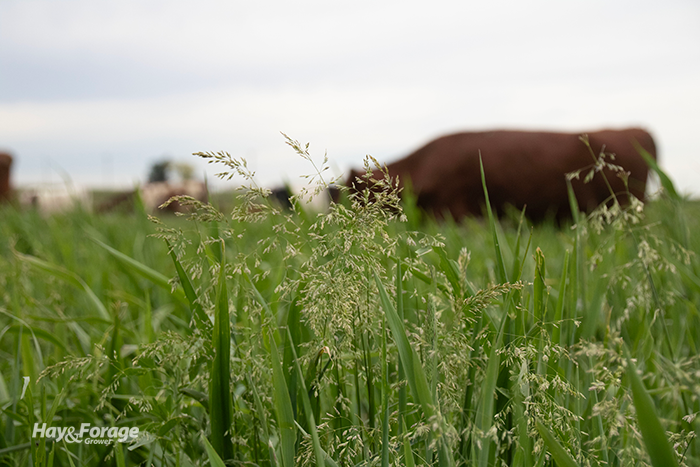
The time of day cool-season grasses are harvested can affect forage nutrient concentrations, and thus, animal intake and digestibility. The driving factor of this fluctuation is the amount of nonstructural carbohydrates plants accumulate throughout the day.
Cool-season grasses can also exhibit seasonal changes in nutrient concentrations — as temperatures rise in the summer, plants develop more structural carbohydrates and become less digestible. In a recently published article, researchers suggest a better understanding of diurnal and seasonal variations in forage nutritive value could help farmers maximize the productivity of their grazing livestock.
The study included AnnMarie Riley, Christ Teutsch, and Ray Smith with University of Kentucky Extension and Isabelle Kagan, Brittany Davis, and Laurie Lawrence from USDA Agricultural Research Service’s Forage–Animal Production Research Unit in Lexington, Ky. They evaluated four cool-season grasses commonly found in Kentucky pastures: orchardgrass, perennial ryegrass, tall fescue, and Kentucky bluegrass.
Collecting the data
For the experiment, researchers seeded monoculture plots of early- and late-maturing cultivars of orchardgrass, perennial ryegrass, tall fescue, and Kentucky bluegrass in central Kentucky in fall 2014 and fall 2016. The following growing seasons (2015 and 2017, respectively), they harvested forage every two to four weeks, maintaining a vegetative state and simulating intensive rotational grazing.
To determine diurnal and seasonal variations in nutritive value, plots were cut either in the morning or evening from May through November. Forage was then flash-frozen and freeze-dried before ground samples were analyzed using near-infrared reflectance spectroscopy (NIRS). Researchers measured acid detergent fiber (ADF), neutral detergent fiber (NDF), crude protein (CP), and in vitro true dry matter digestibility (IVTDMD). They also recorded weekly precipitation and average temperature data.
More fiber in the morning
Results show ADF and NDF were higher when grass was cut in the morning on most harvest dates across both growing seasons in the study. The researchers explain that evening declines in forage fiber can be attributed to dilution from an accumulation of nonstructural carbohydrates throughout the day.
Orchardgrass and perennial ryegrass had the lowest ADF and NDF levels throughout the study; however, all sampled forage had 35% ADF or less, no matter the time of day or year forage was harvested. The researchers attribute this to frequent cutting and suggest that such intensive defoliation may help ensure relatively low forage ADF for grazing livestock.
The study also shows morning-cut forage was not consistently higher in CP than evening-cut forage. However, the researchers note differences in CP concentrations among species, with orchardgrass and perennial ryegrass ranking higher in CP on average compared to tall fescue and Kentucky bluegrass.
In vitro true dry matter digestibility was higher in evening-cut forage than morning-cut forage for most harvests in the study, which would have been expected with lower ADF and NDF values later in the day. With that said, the researchers note that knowing forage IVTDMD may be helpful in selecting species for specific classes of livestock, with high IVTDMD better suited for beef cattle and low IVTDMD for overweight horses.
Overall, forage species selection and grazing management will depend on livestock energy requirements. For more information on the study, and to see individual species data, click here.

